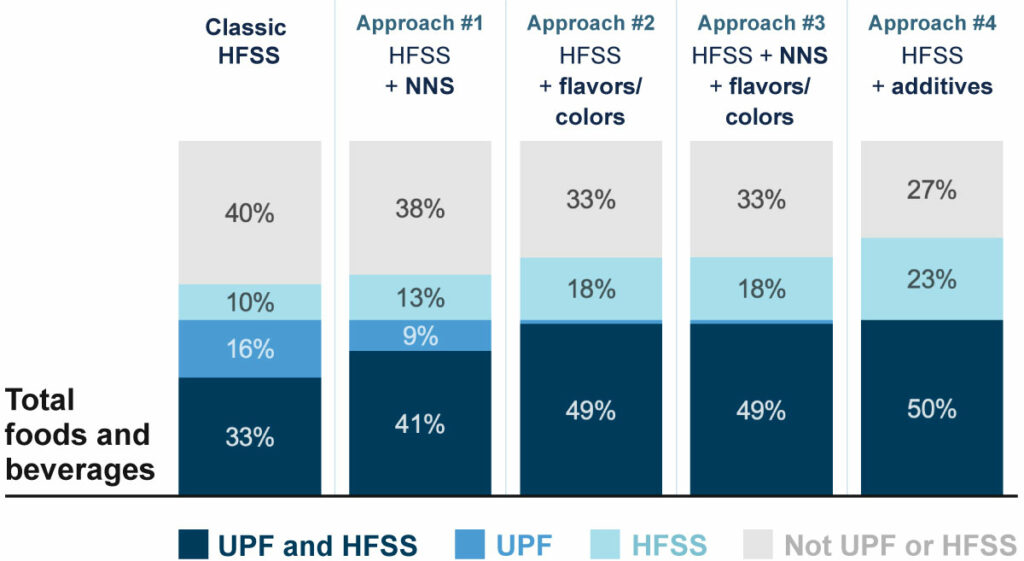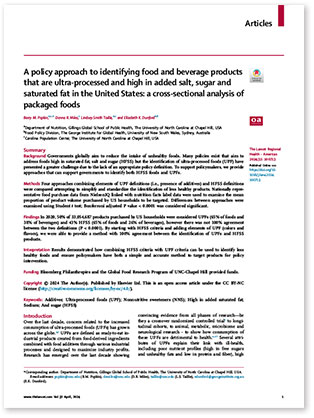A new study from researchers at the Global Food Research Program at UNC-Chapel Hill and The George Institute for Global Health provides guidance for policymakers on how to identify ultra-processed foods and beverages that are also high in salt, sugar, saturated fat, or calorie-dense for regulation.
To date, food policies aimed at improving population nutrition and health have targeted foods and drinks based primarily on their nutritional profile — that is, energy-dense products high in nutrients such as sugar, sodium, or saturated or trans fats have been subject to regulations such as taxes, marketing restrictions, or front-of-package warning labels. With concern mounting over the many health harms associated with high intake of ultra-processed foods, scholars and policymakers have begun exploring how these nutrition-focused policies could target products based on degree of processing.

“Researchers in this area typically use the detailed Nova Classification criteria to identify ultra-processed products in food consumption surveys, but regulatory bodies need a simpler, more objective way to identify ultra-processed food, and ideally one that can be applied globally,” said Barry Popkin, PhD, W.R. Kenan Jr. Distinguished Professor of Nutrition at the UNC Gillings Global School of Public Health, co-director of the Global Food Research Program, and the study’s first author.
For this study, researchers compared different methods for policies to identify products that are ultra-processed and/or high in fat, sugar and/or sodium (HFSS). They used one of the objective dimension of Nova Classification: whether a product’s ingredients list includes one or more additives from 12 Codex classes which are thought to enhance hyper-palatability and are considered markers of ultra-processing. These classes include hundreds of different additives used in food processing and included in product ingredient lists. Researchers tested the ability of four different profiling approaches combining different groups of these additives with the “high in fat, sodium, sugar, or calories” (HFSS) criteria from Chile’s nutrient profiling model to capture products that were both ultra-processed and HFSS. These profiling approaches include:
- HFSS + contains non-nutritive sweeteners
- HFSS + contains colors/flavors
- HFSS + non-nutritive sweeteners + colors/flavors (combination of approaches 1 & 2)
- HFSS + 12 Codex classes of additives (flavor enhancers, colors, emulsifiers, emulsifying salts, sweeteners, thickeners, anti-foaming, bulking, carbonating, foaming, gelling and glazing agents)
Researchers applied these four approaches on a sample of over 33 million food products purchased by a representative sample of roughly 60,000 US consumers in 2020. They found that scenario 4 was most effective, under which 100% of product purchases considered ultra-processed foods under Nova Classification would be targeted for policy intervention. In addition, their findings demonstrate that policies could achieve comparable results using a more streamlined profiling model that simply combines Codex colors and flavors with HFSS criteria, which missed only 1% of ultra-processed products.
Proportion of products purchased by US households in 2020 identified as ultra-processed (UPF) and high in saturated fat, sodium, or sugar (HFSS) under each nutrient profiling approach

UPF = ultra-processed food based on NOVA classification; HFSS = High in saturated fat, sodium, or sugar; NNS = non-nutritive sweetener present in ingredient list; Flavors/color = ≥1 color or flavor/flavor enhancer additive present in ingredient list; Additives = NNS, colors/flavors or other additives (Anti-foaming agent, Foaming agent, Bulking agent, Gelling agent, Thickener, Carbonating agent, Emulsifier, Emulsifying salt, Flavour enhancer, Glazing agent) present in ingredient list.
Notably, if a policy intervention such as mandatory front-of-package warning labels or restrictions on marketing used this approach, nearly 75% of products purchased by U.S. households would be subject to regulation. This highlights the predominance of foods and drinks that do not build health in the US food supply.
This study is the first to show how to operationalize healthy food policies aimed at reducing ultra-processed product consumption using the ingredients list on food packages and can help inform policymakers as they design healthy food regulations such as front of package warnings, marketing restrictions, and taxes on ultra-processed products.
These findings are timely given increasing interest in and momentum behind policies targeting ultra-processed foods. A large-scale “umbrella” review published in the British Medical Journal last month highlighted the imperative to act, finding that exposure to ultra-processed food was associated with 32 different health risks related to mortality, cancer, and mental, respiratory, cardiovascular, gastrointestinal, and metabolic health outcomes.
“Countries around the world are currently trying to figure out how to best guide consumers away from ultra-processed foods and towards more whole or minimally processed options, whether that’s via updated dietary guidelines or policies that will incentivize purchase changes and protect consumers from harm,” said Popkin. “Our findings give policymakers one of the tools they need to implement effective policies towards this end.”
In the United States, the Food and Drug Administration is currently considering options for a front-of-package warning label, which under the current proposal would be applied only to products that contain more than 20% of certain nutrients’ recommended daily intake per serving. “Our study suggests that the FDA needs to go beyond looking at nutrients per serving and include profiling for Codex classes of additives, which number in the hundreds,” said Popkin.
This study was funding primarily by Bloomberg Philanthropies.
AUTHORS
Barry M. Popkin
Donna R. Miles
Lindsey Smith Taillie
Elizabeth K. Dunford
Read the full study in The Lancet Regional Health – Americas.
Learn more about ultra-processed foods and the Nova classification system in our fact sheet:

